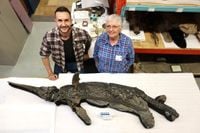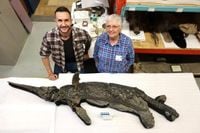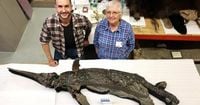On October 10, 2025, palaeontologists announced the discovery and identification of a remarkable new species of ichthyosaur—an ancient marine reptile—found on Dorset’s famed Jurassic Coast. The creature, named Xiphodracon goldencapensis, or the “Sword Dragon of Dorset,” is already making waves in the scientific community for its uniqueness, its completeness, and the intriguing story of its discovery and analysis.
The tale begins back in 2001, when local fossil hunter Chris Moore was scouring the cliffs near Golden Cap, a prominent landmark overlooking the English Channel between Charmouth and Seatown. Moore, no stranger to the region’s fossil-rich layers, made a startling find: the vertebrae of a large marine reptile, still preserved in three dimensions—an unusual occurrence given the crushing forces fossils typically endure over millions of years. As Moore recalled to Dorset Echo, “The end of the tail had washed away but I spotted the vertebrae sticking out and so I got permission to dig. It was still in three-dimensions which is very unusual and it also had skin preserved on it, again very unusual.”
What Moore had unearthed was a near-complete skeleton of an ichthyosaur, a group of marine reptiles that once ruled the seas from the Early Triassic (about 250 million years ago) to the Late Cretaceous (90 million years ago). Ichthyosaurs, often compared in shape to dolphins, ranged in size from one meter to a staggering 25 meters, with Xiphodracon landing somewhere in the middle at about three meters long—roughly the size of a modern dolphin. The specimen included an almost perfectly preserved skull, complete with an enormous eye socket and a long, sword-like snout, features that would later inspire its name.
After its discovery, the fossil was acquired by the Royal Ontario Museum in Toronto, Canada, where it became part of their extensive ichthyosaur collection. There, it remained largely unstudied for over 15 years, a victim of both limited resources and the sheer backlog of paleontological treasures awaiting detailed analysis. According to BBC News, “It has only recently been fully analysed by experts and a paper published identifying it as a new species of ichthyosaur.”
The breakthrough finally came when a trio of palaeontologists—led by Dr. Dean Lomax of the University of Manchester, along with Professor Judy Massare and Dr. Erin Maxwell—undertook a painstaking bone-by-bone description of the skeleton. Their findings, published in Papers in Palaeontology, revealed a host of unique features never before seen in ichthyosaurs. Most notably, Xiphodracon possesses a strange lacrimal bone near the nostril with prong-like bony structures, a detail that sets it apart from thousands of other ichthyosaur specimens found along the UK’s Jurassic Coast.
Dr. Lomax, reflecting on his first encounter with the fossil, told BBC News: “I thought long and hard about the name. Xiphodracon translates to sword-like dragon and that is in reference to that very long, sword-like snout, but also the fact that ichthyosaurs have been referred to as sea dragons for about 200 years.” He emphasized the importance of the find, noting, “During this time ichthyosaurs are incredibly rare, and Xiphodracon is the most complete individual ever found from there, helping to fill a gap. It’s a missing piece of the puzzle in the ichthyosaur evolution.”
The rocks in which the skeleton was found date to the Pliensbachian age of the Early Jurassic, a period spanning roughly eight million years. This era was a tumultuous one for ichthyosaurs, marked by the extinction of several families and the emergence of new ones. Fossils from this slice of time are exceptionally rare, making Xiphodracon not just the first ichthyosaur found in such rocks in over a century, but also perhaps the world’s most complete prehistoric reptile from the Pliensbachian. As Professor Massare explained in the Natural History Museum press release, “Thousands of complete or nearly complete ichthyosaur skeletons are known from strata before and after the Pliensbachian. The two faunas are quite distinct, with no species in common, even though the overall ecology is similar. Clearly, a major change in species diversity occurred sometime in the Pliensbachian. Xiphodracon helps to determine when the change occurred, but we still don’t know why.”
But the story of the “Sword Dragon” doesn’t end with its evolutionary significance. The fossil itself offers a window into the perilous life of a Jurassic marine predator. The skull bears marks suggesting it was bitten by a much larger ichthyosaur, likely causing its death. Dr. Erin Maxwell, co-author of the study, observed, “The skull appears to have been bitten by a large predator—likely another much larger species of ichthyosaur—giving us a cause of death for this individual. Life in the Mesozoic oceans was a dangerous prospect.”
Even more intriguing, the limb bones and teeth of Xiphodracon show signs of malformation, indicating the animal suffered serious injury or disease while alive. “The limb bones and teeth are malformed in such a way that points to serious injury or disease while the animal was still alive,” Maxwell added, underscoring the harsh realities of prehistoric ocean life.
Like its relatives, Xiphodracon likely dined on fish, squid, and ammonites—the iconic spiral-shelled creatures that shared its waters. The remains even appear to show traces of its last meal, a tantalizing hint at the final moments of this ancient hunter.
The discovery also highlights the enduring legacy of Dorset’s Jurassic Coast as a hotbed for paleontological finds. The region has yielded countless ichthyosaur fossils since the pioneering work of Mary Anning in the early 1800s, but new discoveries like Xiphodracon continue to surprise and reshape scientific understanding. Chris Moore, reflecting on his role in the find, told BBC News, “I don’t wish to blow my own ichthyosaur trumpet but I have found a few of them.” In fact, Moore’s tally is somewhere around 15, with several turning out to be new species. As for how he plans to celebrate the latest? “Champagne or a mug of tea, I’m not sure which yet,” he joked.
Now, more than two decades after its unearthing, the “Sword Dragon of Dorset” is set to go on public display at the Royal Ontario Museum, where visitors will be able to marvel at this extraordinary piece of natural history. For scientists and fossil enthusiasts alike, Xiphodracon goldencapensis stands as a testament to the power of patience, curiosity, and the enduring mysteries locked within the rocks of Britain’s ancient shores.



